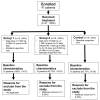Interleukin-6 and Lymphocyte-to-Monocyte Ratio Indices Identify Patients with Intrahepatic Cholangiocarcinoma
- PMID: 38672199
- PMCID: PMC11047984
- DOI: 10.3390/biomedicines12040844
Interleukin-6 and Lymphocyte-to-Monocyte Ratio Indices Identify Patients with Intrahepatic Cholangiocarcinoma
Abstract
Background and aims: Intrahepatic cholangiocarcinoma (iCCA) is a fatal biliary tract cancer with a dismal prognosis due to ineffective diagnostic tools with limited clinical utility. This study investigated peripheral blood indices and cytokine levels to diagnose iCCA.
Methods: Blood samples were collected from healthy subjects (n = 48) and patients with advanced-stage iCCA (n = 47) during a phase I and then phase II trial, respectively. Serum cytokines were measured using a flow cytometer. The peripheral blood indices were estimated based on laboratory data. Multi-linear regression analysis was applied, followed by a probability transformation. The cut-off value and model accuracy were determined using the receiver operating curve (ROC) and the area under the curve (AUC).
Results: The interleukin-6 (IL6) and lymphocyte-to-monocyte ratio (LMR) were potential predictors of iCCA [AUC = 0.91 (0.85-0.97) and 0.81 (0.68-0.93); sensitivity = 0.70 and 0.91; specificity = 0.91 and 0.85, respectively]. Patients with IL6 concentrations higher than 11.635 pg/mL (OR = 23.33, p < 0.001) or LMR lower than 7.2 (OR = 58.08, p < 0.001) are at risk of iCCA development. Patients with IL6 levels higher than 21.83 pg/mL, between 15.95 and 21.83 pg/mL, between 8.8 and 15.94 pg/mL, and lower than 8.8 pg/mL were classified as very high-, high-, intermediate-, and low-risk, respectively. Patients with an LMR between 1 and 3.37, 3.38 and 5.76, 5.77 and 7.18, and higher than 7.18 were classified as very high-, high-, intermediate-, and low-risk, respectively.
Conclusions: LMR is recommended for iCCA screening since the estimation is based on a routine laboratory test, which is available in most hospitals.
Keywords: biliary tract cancer; biomarkers; hepatobiliary cancer; intrahepatic cholangiocarcinoma; prognostic predictor.
Conflict of interest statement
The authors declare no conflict of interest.
Figures
Similar articles
-
[The prognostic value of preoperative peripheral blood inflammatory biomarkers for intrahepatic cholangiocarcinoma after radical resection].Zhonghua Zhong Liu Za Zhi. 2022 Nov 23;44(11):1194-1201. doi: 10.3760/cma.j.cn112152-20210324-00265. Zhonghua Zhong Liu Za Zhi. 2022. PMID: 36380668 Chinese.
-
Comprehensive analysis of genomic mutation signature and tumor mutation burden for prognosis of intrahepatic cholangiocarcinoma.BMC Cancer. 2021 Feb 3;21(1):112. doi: 10.1186/s12885-021-07788-7. BMC Cancer. 2021. PMID: 33535978 Free PMC article.
-
A High-Accuracy Model Based on Plasma miRNAs Diagnoses Intrahepatic Cholangiocarcinoma: A Single Center with 1001 Samples.Diagnostics (Basel). 2021 Mar 29;11(4):610. doi: 10.3390/diagnostics11040610. Diagnostics (Basel). 2021. PMID: 33805513 Free PMC article.
-
Intrahepatic cholangiocarcinoma: Molecular markers for diagnosis and prognosis.Surg Oncol. 2017 Jun;26(2):125-137. doi: 10.1016/j.suronc.2016.12.009. Epub 2017 Feb 20. Surg Oncol. 2017. PMID: 28577718 Review.
-
Molecular diagnosis of intrahepatic cholangiocarcinoma.J Hepatobiliary Pancreat Sci. 2015 Feb;22(2):114-23. doi: 10.1002/jhbp.156. Epub 2014 Sep 29. J Hepatobiliary Pancreat Sci. 2015. PMID: 25267595 Free PMC article. Review.
Cited by
-
Role of interleukins in the pathogenesis of cholangiocarcinoma: A literature review.World J Gastrointest Oncol. 2025 Jul 15;17(7):107341. doi: 10.4251/wjgo.v17.i7.107341. World J Gastrointest Oncol. 2025. PMID: 40697231 Free PMC article. Review.
-
Conversion treatment for advanced intrahepatic cholangiocarcinoma: Opportunities and challenges.World J Gastroenterol. 2025 Apr 21;31(15):104901. doi: 10.3748/wjg.v31.i15.104901. World J Gastroenterol. 2025. PMID: 40309227 Free PMC article. Review.
-
Nomogram for Predicting Survival Post-Immune Therapy in Cholangiocarcinoma Based on Inflammatory Biomarkers.Cancer Control. 2024 Jan-Dec;31:10732748241305237. doi: 10.1177/10732748241305237. Cancer Control. 2024. PMID: 39638310 Free PMC article.
-
Predictive value of the monocyte count for determining the risk of postoperative moderate-to-severe ARDS in patients undergoing one-lung ventilation during radical treatment of esophageal cancer.Front Med (Lausanne). 2025 Feb 11;12:1510788. doi: 10.3389/fmed.2025.1510788. eCollection 2025. Front Med (Lausanne). 2025. PMID: 40007585 Free PMC article.
References
-
- Banales J.M., Marin J.J.G., Lamarca A., Rodrigues P.M., Khan S.A., Roberts L.R., Cardinale V., Carpino G., Andersen J.B., Braconi C., et al. Cholangiocarcinoma 2020: The next horizon in mechanisms and management. Nat. Rev. Gastroenterol. Hepatol. 2020;17:557–588. doi: 10.1038/s41575-020-0310-z. - DOI - PMC - PubMed
-
- Wongkham S., Silsirivanit A. State of serum markers for detection of cholangiocarcinoma. Asian Pac. J. Cancer Prev. 2012;13:17–27. - PubMed
-
- Kulma I., Panrit L., Plengsuriyakarn T., Chaijaroenkul W., Warathumpitak S., Na-Bangchang K. A randomized placebo-controlled phase I clinical trial to evaluate the immunomodulatory activities of Atractylodes lancea (Thunb) DC. in healthy Thai subjects. BMC Complement. Med. Ther. 2021;21:61. doi: 10.1186/s12906-020-03199-6. - DOI - PMC - PubMed
-
- Na-Bangchang K., Tongsiri N., Plengsuriyakarn T., Sae-heng T., Kongjam P., Kulma I., Worrabannnakorn S., Karbwang J. Phase II-a clinical trial to evaluate safety and efficacy of capsule formulation of the standardized extract of Atractylodes lancea (Thunb.) DC. in patients with advanced stage intrahepatic cholangiocarcinoma. J. Tradit. Complement. Med. 2023 in press .
Grants and funding
LinkOut - more resources
Full Text Sources





